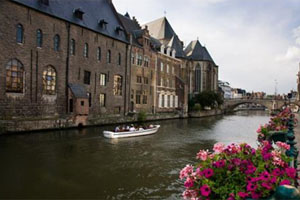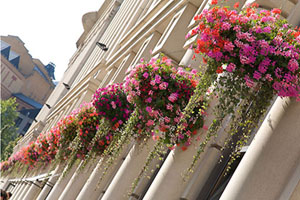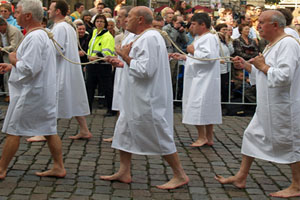Workshop
19-21 Sept, 2012Het Pand
Onderbergen 1, Ghent
• Program
• Registration
Doctoral Course
17-18 Sept, 2012Plateau
J. Plateaustraat 22,Ghent
• Program
• Registration
Important Dates
June, 1: Digest submission
June, 15: Digest acceptance
July, 1: Early registration
Oct, 8: Full paper submission
-
OIPE Workshop
-
Doctoral Course
-
Paper Info
-
Registration
-
Committees
-
Support
-
Organizing your Trip
-
About Ghent
History
City on the river mouth

Between 1100 and 1500 Ghent played a prominent role among the major cities of north-west Europe. The number of inhabitants from the 13th to the 15th century is estimated at around 65,000, which is just slightly less than Paris, but considerably more than London or Hamburg for instance. Ghent owed its metropolitan character in the Middle Ages to its production of luxury woollen cloth and its excellent geographic location at the confluence of the two main rivers in Flanders, the Leie and the Scheldt, which provided good opportunities for trade. The flemish name 'Gent' is probably derived from the Celtic 'Ganda', which meant confluence.
Real diamond of FlandersNowadays, Ghent is the fourth largest city of Belgium with about 250.000 inhabitants. It is not as big as Antwerp but bigger than Bruges. It is also less famous among tourists than the often praised Bruges. However, for some people Ghent is the real diamond of Flanders and Belgium. In a unique way, Ghent has managed to preserve its medieval power while keeping up with the times. The city center alone is a showcase of medieval Flemish wealth and commercial success. Modern Ghent certainly cannot be overlooked in Belgium. The city has an important harbor, thanks to the canal Ghent-Terneuzen which allows sea-going vessels to bring their products to the city and its industrial hinterland. The Ghent University continues to grow in importance. The presence of so many young people and students has turned Ghent into an important Flemish cultural center.
Flower city
Ghent is also the flower city of Belgium. Flower growers from the region around Ghent sell their beautiful begonia's and azalea's all over the world. Every 5 years the successful Ghent Flower Show attracts thousands to the city. The tourist will not have eyes enough to admire the awesome architectural wealth, which offers a splendid combination of impressiveness and idyllic charm of the proud and (in former times) often rebellious city of Ghent.
StropkeThe people of Ghent proudly wear the nickname 'Stropke', which is actually the round part of the rope through which a convict has to stick his head before being hanged. The citizens of Ghent received this name because of the punishment inflicted on the city by its most famous citizen, Emperor Charles V. In 1537 Ghent had refused to pay more taxes for a new war of Charles V against the king of France. To deal with his rebellious birth-city for once and for all, Charles V had the city walls destroyed. He also abolished most of the city's privileges and ordered the most important citizens to appear before him to ask for mercy while carrying a rope around their necks, as a sign that they were ready to be hanged if the Emperor would order it.
 Fast Facts and Orientation
Fast Facts and Orientation
Country: Belgium
Location: East Flanders
Area: 60 square miles / 155 square kilometers
Population: approximately 250.000
Language: Dutch, also varying degrees of Flemish, French and German
Currency: euro (EUR)
World time zones: GMT +1 (summer time GMT+2)
Country dialing code: +32
Telephone area code: 09
Average September temperature: 17°C / 63°F